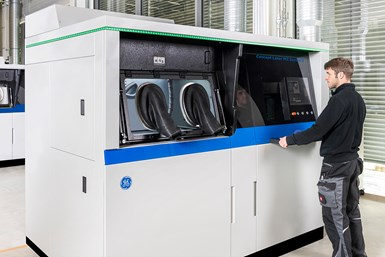GE Aviation Singapore Approved for Metal Additive Engine Component Repairs
The company says metal 3D printing enables customization and complexity for repair parts, with repairs customized for each individual part because each part wears differently during service.

GE Additive Concept Laser M2 system. Photo Credit: GE Additive
GE Aviation says its Loyang, Singapore, facility is the first maintenance, repair and overhaul (MRO) facility worldwide that has been approved to use metal additive manufacturing (AM) for commercial jet engine component repairs. GE Aviation Engine Services Singapore (GE AESS) currently employs more than 1,700 employees and accounts for more than 60% of GE Aviation’s global repair volume.
The company says 3D printing enables customization and complexity for repair parts. Normally, 3D printed parts are typically printed using STL files generated from CAD drawings — where the goal is to produce identical parts conforming to the blueprint. However, when repairing used parts, the repair has to be customized for each individual part because each part wears differently during service.
The company says that additive technology in repairs also offers the possibility of embracing complexity, rather than shying away from it. “Now designers are making use of the ability to produce new designs that couldn’t be imagined or manufactured before with traditional methods,” says Chen Keng Nam, executive manufacturing leader at GE AESS in Singapore.
GE Additive also sees the potential for metal additive technology in MRO. “In this part of the supply chain, our customers truly value faster turnaround time and that’s what we are achieving,” says Iain Rodger, managing director at GE AESS. “Using our GE Additive Concept Laser M2 machines typically halves the amount of time it takes us to repair these aircraft parts.”
Rodger says his teams are already using additive technology to repair parts in GE Aviation’s CF6 engines, which the company says is one of the most reliable and best-selling commercial engine on wide-body aircraft. The next goal is to include parts on the CFM56, which the company says is the best-selling engine in commercial aviation history.
Related Content
-
“Mantis” AM System for Spacecraft Uses Induction for Deposition
The metal 3D printing system melts wire without lasers. 30-foot-diameter parts are built on a rotary-feed system that eliminates the need for a large machine frame or gantry.
-
Why AM Leads to Internal Production for Collins Aerospace (Includes Video)
A new Charlotte-area center will provide additive manufacturing expertise and production capacity for Collins business units based across the country, allowing the company to guard proprietary design and process details that are often part of AM.
-
Beehive Industries Is Going Big on Small-Scale Engines Made Through Additive Manufacturing
Backed by decades of experience in both aviation and additive, the company is now laser-focused on a single goal: developing, proving and scaling production of engines providing 5,000 lbs of thrust or less.













